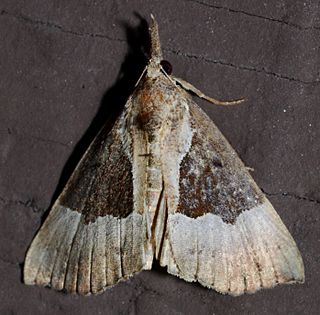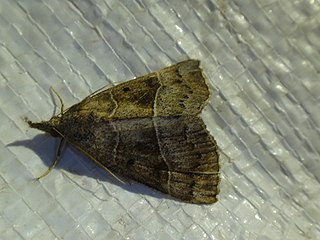
Hypena is a genus of moths in the family Erebidae. It was first described by Franz von Paula Schrank in 1802. These non-migratory moths overwinter as pupae and almost never come to bait as adults.

Hypena proboscidalis, the snout, is a moth of the family Erebidae. The species was first described by Carl Linnaeus in his 1758 10th edition of Systema Naturae.

Dichromia is a genus of moths of the family Erebidae first described by Achille Guenée in 1854.
Stenhypena is a genus of moths of the family Erebidae erected by George Hampson in 1895. The type species was first found in Sri Lanka.

Hypena bijugalis, the dimorphic bomolocha, dimorphic hypena or toothed snout-moth, is a moth of the family Erebidae. The species was first described by Francis Walker in 1859. It is found in North America from Nova Scotia across southern Canada to Vancouver Island, south over the whole United States to Florida.
Hypena edictalis, the large bomolocha, is a moth of the family Erebidae. The species was first described by Francis Walker in 1859. It is found in North America from Quebec and Maine south to Virginia and Kentucky, west to the foothills of Alberta and the Peace River area of British Columbia.

Hypena palparia, the variegated snout-moth or mottled bomolocha, is a moth of the family Erebidae. The species was first described by Francis Walker in 1861. It is found in North America from Nova Scotia west across southern Canada to British Columbia, and south to Alabama and Texas.

Hypena deceptalis, the deceptive hypena or deceptive bomolocha moth, is a moth of the family Erebidae. The species was first described by Francis Walker in 1859. It is found in North America from Manitoba to Quebec, south to Florida and Texas. It is absent from much of Gulf Coastal Plain though.

Hypena abalienalis, the white-lined hypena or white-lined bomolocha moth, is a moth of the family Erebidae. The species was first described by Francis Walker in 1859. It is found from southern Canada to northern Florida and Texas.

Hypena perspicua is a moth in the family Erebidae first described by John Henry Leech in 1900. It is found in Taiwan.

Hypena gonospilalis is a species of moth of the family Erebidae first described by Francis Walker in 1866. It is found across the South Pacific, including the Cook Islands, Japan and Taiwan as well as the Australian state of Queensland.

Hypena conscitalis is a moth of the family Erebidae first described by Francis Walker in 1866. It is found throughout Africa, from Senegal to South Africa, in South and South-East Asia as well as in Australia and on some Pacific and Indian Ocean islands.
Hypena extensa, is a moth of the family Erebidae first described by Francis Walker in 1866. It is found in India and Sri Lanka.
Hypena varialis, is a moth of the family Erebidae first described by Francis Walker in 1866. It is found in India and Sri Lanka.











